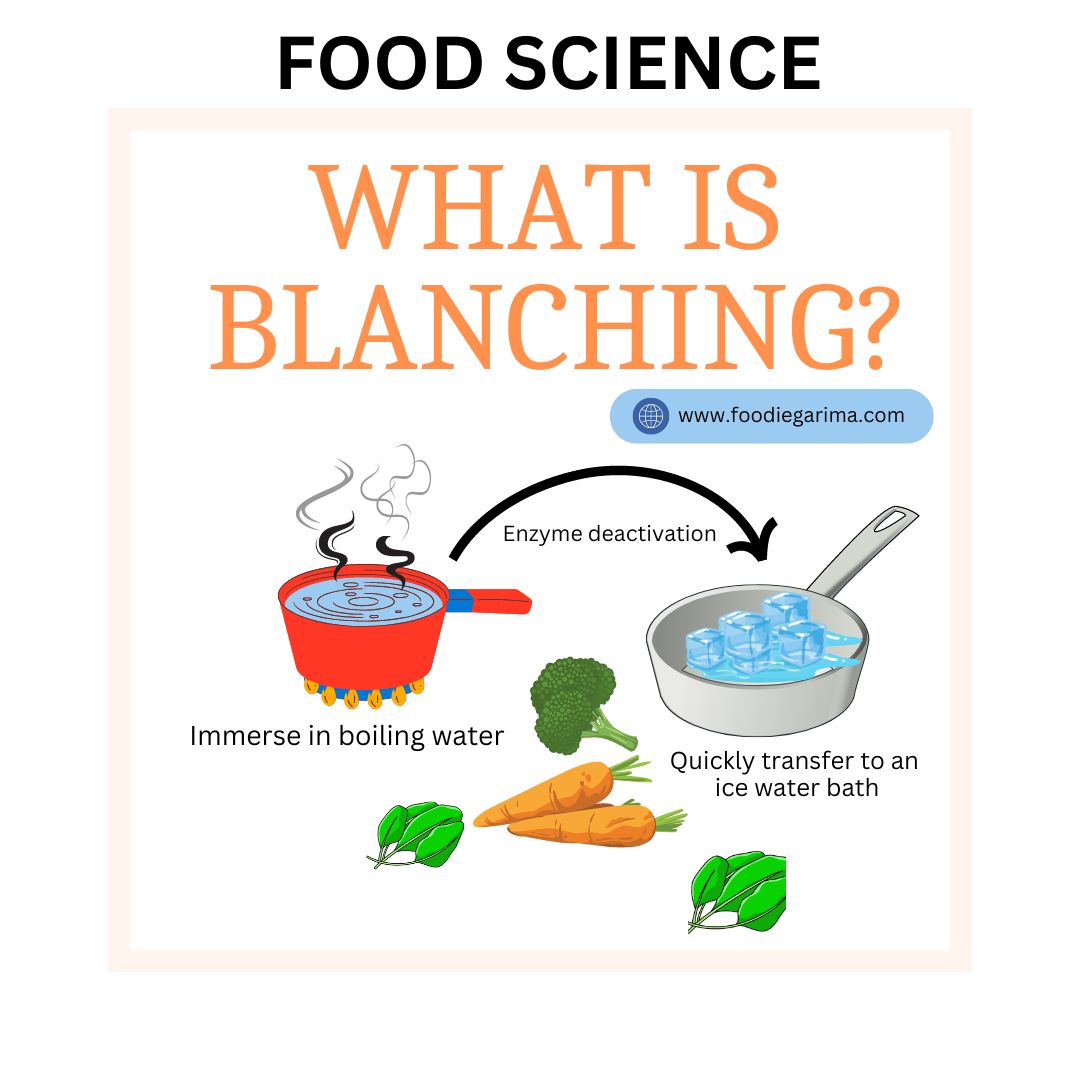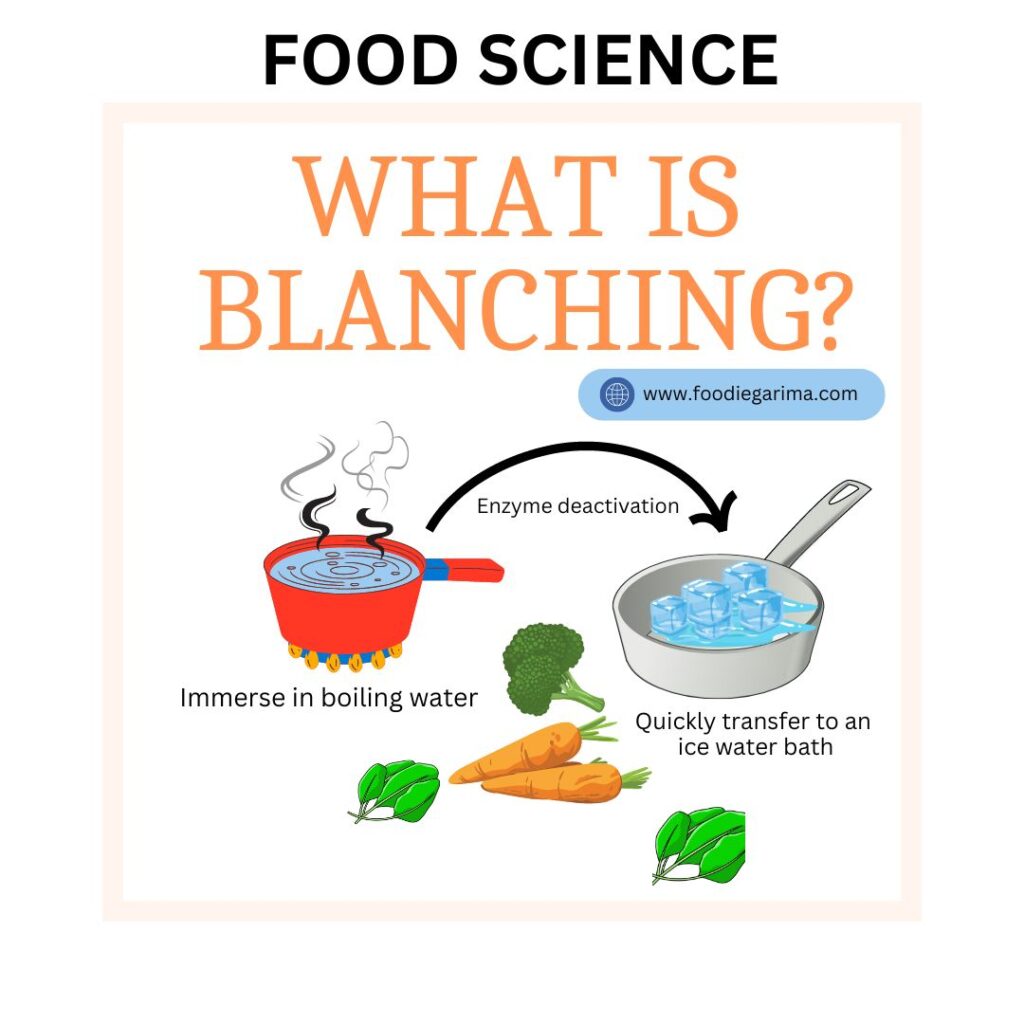8 September, 2024
What is Blanching? How to Blanch? Science Behind Blanching

What is Blanching?
Blanching is a crucial technique in food processing, particularly in the preservation of vegetables. It involves briefly boiling food items, usually vegetables, and then quickly plunging them into ice-cold water to halt the cooking process. The purpose of blanching is not just to cook the vegetables, but to preserve their natural colors, flavors, and nutrients.
In many culinary traditions, blanching is the first step before further processing, whether that’s freezing, sautéing, stir-frying, or even grilling.
Blanching Process
- Heating: Vegetables are immersed in boiling water or exposed to steam for a specific duration, usually 1 to 5 minutes, depending on the type of vegetable. This initial heating deactivates enzymes, softens the cellular structure, and enhances color by removing air trapped in the cells.
- Cooling: After the vegetables are blanched, they are quickly transferred to an ice water bath. This “shocking” process rapidly cools the vegetables, stops the cooking process and locks in color, texture, and nutrients.

Why Blanch?
Blanching has several advantages, making it a critical step in food preparation.
- Preserves Color: By deactivating enzymes and stabilizing pigments, blanching helps vegetables retain their vibrant hues.
- Maintains Texture: While some softening occurs, blanching prevents the vegetables from turning mushy, preserving a firm texture.
- Locks in Nutrients: The quick cooking and cooling process helps retain most of the vegetable’s essential nutrients like vitamins and antioxidants that would otherwise degrade during storage. Since the exposure to heat is minimal, essential nutrients like Vitamin A and C remain intact.
- Enhancing Freezing and Storage Life: Blanching is essential for preparing vegetables for freezing as it extends the shelf life of vegetables, preventing spoilage and nutrient loss by deactivating enzymes and eliminating microorganisms.
Blanching in Different Cuisines
Blanching is a widely-used technique in various culinary traditions. From Asian countries, where it’s used to soften leafy greens before stir-frying, to Western kitchens where it prepares vegetables for freezing, Blanching is a versatile and vital step.
Science Behind Blanching
Blanching isn’t just a cooking method – it’s a scientific process that affects the cellular structure of vegetables, initiates several chemical reactions within the vegetable tissue, affecting color, flavor, and nutrients.
Role of Enzymes in Blanching
One of the primary reasons for blanching is the deactivation of enzymes that can negatively affect the quality of vegetables during storage. Here is how enzymes are involved:
1. Enzyme Activity:
Vegetables naturally contain various enzymes, such as polyphenol oxidase, peroxidase, lipoxygenase, and chlorophyllase. These enzymes control processes like browning, flavor deterioration, and nutrient loss over time.
2. Enzyme Deactivation:
- Blanching is primarily done to deactivate these enzymes, particularly polyphenol oxidase and peroxidase, which cause browning in vegetables (similar to how an apple turns brown after being cut). Heat disrupts the protein structure of enzymes, rendering them inactive.
- Enzymes that degrade chlorophyll, such as chlorophyllase, are also deactivated, preventing the breakdown of the bright pigment into a duller, brownish-green hue.
3. Prevention of Spoilage:
Enzymes like lipoxygenase lead to the oxidation of fats, which can cause rancidity and off-flavors in frozen or stored vegetables. Blanching halts this enzymatic activity, ensuring that vegetables maintain their flavor and nutritional value over time.
Impact on Cellular Structure
Vegetables consist of rigid cell walls made of cellulose and pectin, which give them their firmness. When vegetables are blanched, the heat from blanching causes partial breakdown of the cell wall components, primarily cellulose and hemicellulose, which leads to a softer texture. However, blanching is brief, it doesn’t completely dissolve these components, which prevents the vegetables from becoming mushy.
For instance, in the case of Tomatoes, the heat causes the skin to loosen, making it easy to peel without damaging the flesh.
Chemical Changes in Food During Blanching
1. Pigment changes:
- In green vegetables like Spinach or Broccoli, chlorophyll gives them their vibrant color. Blanching initially intensifies this green color by removing air from the cells, but prolonged exposure to heat can degrade chlorophyll into pheophytin, leading to a duller color. Short blanching prevents this.
- For red, orange, and yellow vegetables (rich in carotenoids, such as carrots and sweet potatoes), blanching has minimal impact on their pigments, as carotenoids are heat-stable. This preserves their bright colors.
2. Flavor Alterations:
- The brief heat exposure reduces bitterness in some vegetables by breaking down glucosinolates (found in cruciferous vegetables like Brussels sprouts), resulting in a milder flavor.
- The blanching process also reduces compounds like oxalic acid, which may cause astringency in vegetables like Spinach.
Role of Blanching in Food Processing
Blanching is a key step in the industrial processing of vegetables. It’s not only essential for home cooks but also in large-scale food industries. Whether you are preparing food for freezing, drying, or canning, Blanching helps to maintain the quality of the product for longer periods.
Industrial Use of Blanching
In large-scale operations, Blanching ensures uniformity in color, texture, and taste, making it ideal for mass production of frozen and canned vegetables.
Application in Commercial Frozen Foods
Blanching is essential for the production of high-quality frozen vegetables, helping maintain their appearance and flavor over time.
Preparing Sauces, Soups or Salsas
In preparing sauces or canning, Blanching Tomatoes is the first step to remove the tough outer skin easily without damaging the flesh.
How to Blanch Vegetables
Blanching is a straightforward process, but it requires precision. Here is how you can do it at home.
Step-by-Step Guide to Blanching
Preparing the Vegetables
Begin by washing and trimming your vegetables. Cut them into uniform pieces to ensure even Blanching.
Boiling Water and Ice Bath Preparation
Fill a large pot with water and bring it to a rolling boil. Meanwhile, prepare a large bowl of ice water for cooling.
Blanching Time for Different Vegetables
Each vegetable requires a different blanching time. For example:
- Leafy greens: 1 – 2 minutes
- Carrots: 3 – 5 minutes
- Beans: 2 – 3 minutes
Leafy Greens: Leafy Greens like Spinach need only 1 – 2 minutes in boiling water before being shocked in an ice bath.
Blanching helps retain its vibrant green color and prevent bitterness by deactivating enzymes. This makes it perfect for using in dishes later without losing nutrients like vitamins A and C.
Root Vegetables: Root Vegetables, such as Carrots, require a longer blanching time of 3 – 5 minutes.
Beans and Peas: Beans and Peas need 2 – 3 minutes to preserve their crunch.
Green Beans when blanched, they retain their bright green color and crisp texture. The process also helps to keep their fiber content intact while preserving them from becoming mushy when frozen.
Tomatoes: For Tomatoes, boiling them for 30 – 60 seconds is sufficient for easy peeling.
Tomatoes benefit from a quick blanch to make peeling easier. Boil them for just 30-60 seconds, then transfer them to an ice bath, and the skin will peel off effortlessly. This method is commonly used in recipes that require peeled tomatoes, such as sauces, soups, and salsas.
Key Factors to Consider During Blanching
- The water must be boiling rapidly.
- Timing is crucial: Under-blanching can leave enzymes active, leading to a loss in color during freezing or further cooking. Over-blanching, on the other hand, can lead to nutrient loss and mushy vegetables.
Is Blanching Really Necessary?
Blanching is an essential step in food preparation, but is it always necessary?
Pros of Blanching
- Preserves color, texture, and nutrients
- Extends shelf life for freezing and storing
- Reduces spoilage caused by enzymes
Cons of Blanching
- Time-consuming
- Can lead to nutrient loss if not done properly
- Requires additional efforts (first brief boiling, and then rapid cooling)
Alternatives to Blanching
For those looking for alternatives, steaming and microwaving are other methods to deactivate enzymes and preserve vegetables.
In conclusion, blanching is a controlled thermal process that carefully balances the preservation of color, texture, flavor, and nutrients while deactivating enzymes that would otherwise cause degradation. Through a combination of chemical changes, cellular restructuring, and enzyme deactivation, blanching effectively extends the shelf life of vegetables while maintaining their quality.
Blanching remains one of the most important techniques in food preservation and preparation. Whether you are a home cook or in the food industry, blanching is vital to keeping your vegetables fresh, flavorful, and nutritious. As Food Science advances, blanching may continue to evolve, but its core purpose will always be to ensure the highest quality in vegetable preservation.